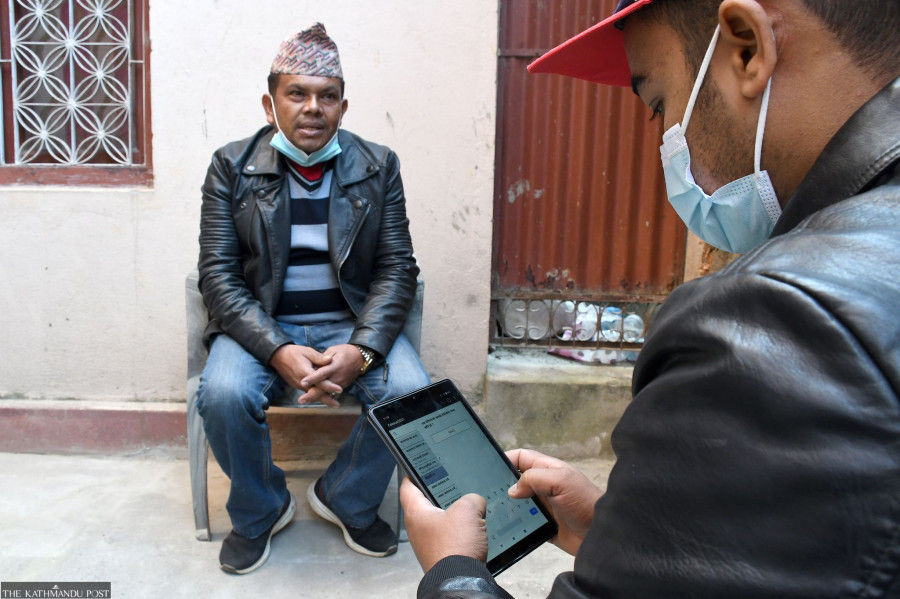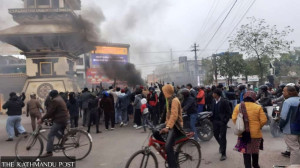National
Main census questionnaire does not recognise queer people
The gender category ‘others’ in Form 1 of the census has been removed in Form 2 of the census, much to the dismay of activists.
Aakriti Ghimire
“A queer friend of mine who is the head of the household could not list themselves based on their gender identity in the main questionnaire of the census. The census aggregates the head of the household only as man or woman,” says Sarita KC, executive director of Mitini Nepal, an LGBTI organisation.
“They did not have a box to identify themselves based on their gender or sexual identity in the main questionnaire.”
Nepal was widely praised by international media and community for making the 2021 census inclusive by adding an option of ‘others’ beyond the two genders (male and female) to count the queer population.
However, this option of ‘others’ has been limited to form one—that has 25 questions—used for the first phase of the census that collected data for House and Household Listing.
The second form—with 55 questions—used for the second phase of the census doesn’t have the option ‘others.’
While the category of ‘others’ itself was considered discriminatory by Nepal’s queer population as it took away their right to self-determine their gender identity and sexual orientation, the exclusion of ‘others’ in the main questionnaire of the census is a heavy compromise that queer activists had to make in the face of lack of resources and international acceptance of the national census.
“We wanted to include the breakdown of gender, albeit limited to ‘others,’ even in the main questionnaire, but due to various constraints, we had to compromise. We had to take whatever little we could get,” says Pinki Gurung, president of the Blue Diamond Society, an LGBTI organization.
The 2021 census comprises three separate questionnaires: House and Household Listing, the main questionnaire, and the Community Questionnaire.
The first phase of the census called the House and Household Listing took place from September 15 to October 4.
The second phase of the census began on November 11 and is set to end on November 25.
“The census takes place in two phases—phase I and phase II,” says Hem Raj Regmi, Deputy Director General at the Central Bureau of Statistics (CBS). “We had included the option ‘others’ in the form used in the first phase, but it isn’t included in form II to be used in the second phase.”
Various factors were taken into consideration after consulting primary stakeholders, organizations working for queer rights—such as the Blue Diamond Society, Mitini Nepal, and Inclusive Forum Nepal—while taking such decisions, Regmi says.
International standards, budgeting concerns, lack of extensive knowledge and vocabulary, and Nepal’s social acceptance of the queer community played a crucial role in such exclusion, according to the stakeholders.
“After a series of meetings with various organisations, we decided not to include the gender category of ‘others’ in form II. Firstly, individuals who do not identify within the gender binary of male and female are hesitant to speak openly about their gender identities,” says Regmi.
In the census of 2011, only 1,500 individuals identified themselves under the ‘third gender’ category. This number, queer activists say, doesn’t reflect the ground reality.
Data collection of queer individuals is affected by Nepali society’s acceptance of the queer community.
“Given that many people weren’t comfortable disclosing their gender identities, and the discourse on gender is still evolving and many people in Nepal are completely unaware or ignorant about it, it affects the data collection for queer population,” says Sharu Joshi Shrestha, a gender activist who has led several UN programmes.
The CBS also emphasizes that global acceptance and validation of the national census is contingent upon meeting international standards of data collection.
The Handbook on Management and Organization of National Statistical Systems published by the United Nations Statistics Division (UNSD) identifies gender as male and female only. It explicitly determines the need to categorize gender in any instance possible to realize Goal 5 of the Sustainable Development Goals by 2030, without addressing the queer community, throughout the handbook.
“Queer populations are considered hard-to-reach populations. And according to international standards, manuals provided by the United Nations Statistics Division (UNSD), we face constraints while collecting data on their population in the census, especially,” Regmi said.
The 2020 Census of the US collected data only on same-sex couples—the number of same-sex couples that are raising kids, the geography of where same-sex couples live, and the race and ethnicity of people in same-sex couples—and not on their gender identities and sexual orientation.
The England and Wales census 2021 collected voluntary information on gender identities and sexual orientation for people aged 16 and over.
New Zealand’s census of 2023 will be collecting data on gender, sex, variations of sex characteristics, and sexual identity.
In addition, budgeting and resource constraints were other reasons given by the CBS for such exclusion, Gurung says.
Stakeholders also said they faced various complications in designing the questionnaires. “While it was important to include ‘others’ in the second form, and not just the first, we ran into various complications. For example, marriage among same-sex couples or queer folks hasn’t been recognized legally yet, and we don’t have the vocabulary to identify their marriage, or data on pregnancy, or divorces,” says Shrestha.
Shrestha has been involved with three national censuses and is actively involved with the National Census 2021.
However, queer activists strongly share that they wanted to include—at least ‘others’—as a gender category in the main questionnaire too. But, they argue that inability to identify themselves according to their gender identities and sexual orientation leads to a loss of their true representation.
“Not being able to identify oneself within the gender spectrum in the national census makes them feel unrepresented. And not having this comprehensive data—based on household heads, marriages, property ownership, income—leaves us behind in pushing forward policies for representation at local and national levels,” shares Gurung.
KC echoes Gurung’s concerns.
“I, as a bisexual woman want to identify myself, not just as a woman but based on my sexual orientation. However, I am not able to do that,” KC told the Post over the phone.
KC believes that her identity as a woman versus a bisexual woman is different, and having the data based on their gender identities and sexual orientation could lead to reservations based on our intersectional identities. “With comprehensive datasets, we can push for representation at local level elections, and even during the formation of ministries. Policies and programs can be designed keeping in mind these intersectionalities.”
Queer activists and stakeholders had to compromise with their minimal representation through the House and Household Listing because of the various factors such as budget and resource constraints, lack of guidelines in collecting national data of queer population in international handbooks, lack of vocabulary in addressing queer relationships, and the apprehensions of Nepali society in accepting queer individuals.
Nonetheless, activists especially have always questioned the accuracy of Nepal’s decennial data, which the government and non-governmental organisations rely on to distribute economic, social, and political resources.
“While this data, especially on queer population collected through form I, probably will not be entirely accurate, it will at least provide a baseline for us to start with,” says Shrestha.
Queer activists, however, commend the CBS for personally inviting them and providing a space for them to train master trainers on gender-sensitive approaches to census data collection, by adhering to the Gender and Social Inclusion Guidelines.
“We were included in various levels of training as well. The CBS invited us and gave us the space to conduct our own workshops and training. They welcomed us to submit manuals and booklets to include in the training materials as well,” said KC, who has been advocating for queer rights for seven years now.
“Queer-led organizations provided plenty of materials after the training to sensitize the master trainers – who in turn train census officers, supervisors, and enumerators – on issues of gender and sexuality. Queer community members were themselves present during the training,” says Shrestha, who is also a board member at Nepal Policy Institute, an international public policy think-tank.
The CBS trained 8,500 census supervisors in April to conduct the House and Household Listing. In early November, 39,000 enumerators from across the country were trained for phase two of the census.
“Despite all the materials and training, the level at which the master trainers, census supervisors, and enumerators have grasped these complex nuances of gender and sexual orientation isn’t something that we can determine yet,” says Shrestha.
The CBS has proposed a different focus survey for the queer community in Nepal addressing the wide spectrum of gender identities and sexual orientation after the national census. However, the dates of the survey haven’t been released yet.
While activists acknowledge that the survey will not cover grounds as extensively as the national census, they are hopeful that the breakdown of the gender spectrum in the survey will provide them with reliable data to advocate for their issues in the future.
“Perhaps by the next census we will have an exhaustive breakdown of gender and sexual minorities, not just in the Household Listing but also in the main questionnaire—in the manner that disability has been broken down in this census,” says KC.




 6°C Kathmandu
6°C Kathmandu







%20(1).jpg&w=300&height=200)







